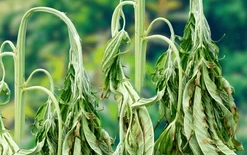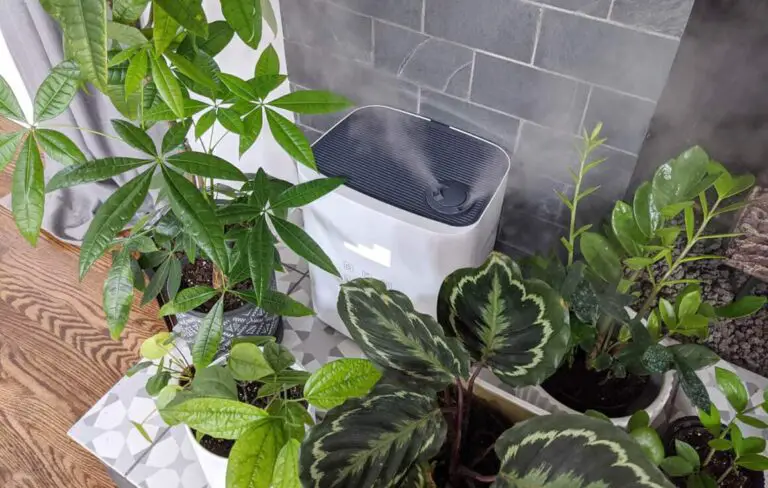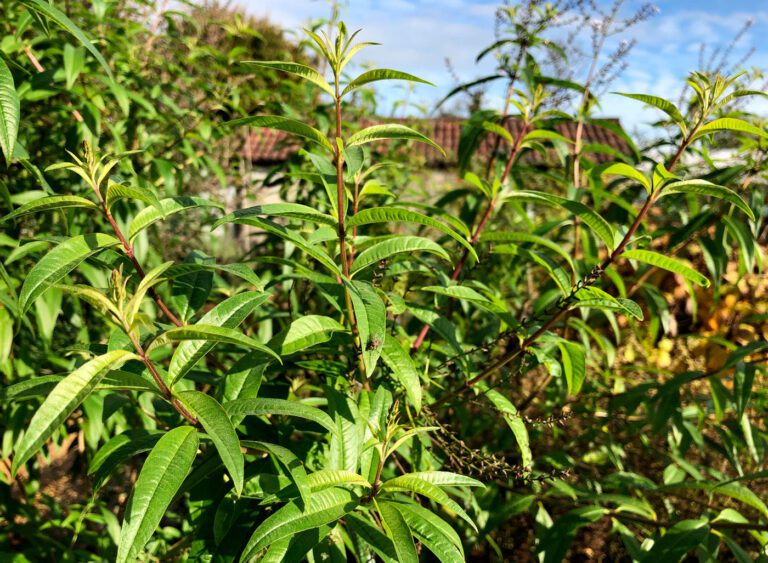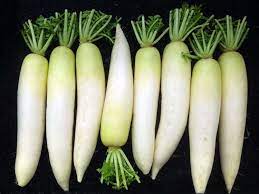Fusarium Wilt: What It Is, How to Prevent It, and How to Treat It
Table of Contents
Understanding the Nature of Fusarium Wilt: A Devastating Plant Disease
Fusarium wilt is a devastating plant disease that affects a wide range of crops, causing significant economic losses to farmers and gardeners alike. This fungal disease is caused by various species of the Fusarium genus, particularly Fusarium oxysporum, which attacks the vascular system of plants, interfering with their ability to transport water and essential nutrients. The result is wilting, stunting, and ultimately death of the infected plants.

One of the most alarming aspects of Fusarium wilt is its ability to persist in the soil for long periods, making it difficult to eradicate once established. Moreover, this pathogen can be introduced into previously healthy soil through infected plant debris, contaminated irrigation water, or even infected seeds. Once the pathogen finds its way into the roots of susceptible plants, it colonizes the vascular tissues, obstructing the flow of water and nutrients, and leading to the characteristic wilting symptoms. With such a devastating impact on a wide range of crops, it is crucial for gardeners and farmers to understand the nature of Fusarium wilt and take appropriate measures to prevent its spread and manage its outbreaks effectively.
Recognizing the Symptoms and Early Signs of Fusarium Wilt
Fusarium wilt is a destructive plant disease that affects a wide range of plant species, leading to significant economic losses for gardeners and farmers alike. Recognizing the symptoms and early signs of Fusarium wilt is crucial in order to promptly take action and prevent further spread of the disease.
One of the earliest indicators of Fusarium wilt is wilting and yellowing of the leaves on affected plants. This initial symptom often starts in specific branches or sections of the plant and gradually spreads throughout. As the disease progresses, the leaves may become dry and brittle, eventually falling off. Additionally, you may notice a brown discoloration in the vascular tissues of the plant, particularly when you cut the stem. This is caused by the fungus blocking the flow of water and essential nutrients within the plant, resulting in wilting and eventual death.
Another key symptom to look out for is the presence of discolored streaks or stripes on the stems of affected plants. These streaks can vary in color, ranging from brown to black. The discoloration is a result of the fungus invading the vascular system of the plant and disrupting its normal function. Moreover, plants affected by Fusarium wilt often exhibit stunted growth and reduced yield. It is important to note that these symptoms may vary depending on the specific host plant and the strain of the Fusarium fungus involved.
Identifying Common Host Plants Affected by Fusarium Wilt
Fusarium wilt is a devastating plant disease that affects a wide range of host plants. Identifying the common host plants affected by Fusarium wilt is crucial for effective prevention and control strategies. Here are some of the most commonly affected host plants:
1. Tomatoes: Fusarium wilt is a major concern for tomato growers. Varieties such as ‘Beefsteak’, ‘Brandywine’, and ‘Better Boy’ are particularly susceptible to the disease.
2. Bananas: Fusarium wilt, also known as Panama disease, poses a significant threat to banana plantations worldwide. The Cavendish variety, which is widely cultivated for commercial purposes, is highly susceptible to the disease.
3. Cucumbers: This popular vegetable is susceptible to Fusarium wilt, especially the slicing and pickling varieties. ‘Straight Eight’ and ‘Marketmore 76’ are common cultivars affected by the disease.
4. Melons: Fusarium wilt can have a severe impact on melon crops, particularly watermelon and cantaloupe. Popular varieties such as ‘Crimson Sweet’ and ‘Hale’s Best’ are vulnerable to the disease.
5. Potatoes: Certain potato varieties are susceptible to Fusarium wilt, causing significant yield losses. ‘Russet Burbank’ and ‘Yukon Gold’ are examples of commonly affected cultivars.

These are just a few examples of host plants that can fall victim to Fusarium wilt. It’s important for gardeners and farmers to be aware of the susceptible varieties in order to implement proper preventive measures and minimize the spread of the disease. Stay tuned for further information on effective prevention and control strategies in the upcoming sections.
Exploring the Causes and Factors that Contribute to Fusarium Wilt Outbreaks
Fusarium wilt is a highly destructive plant disease that can have devastating impacts on agricultural crops and garden plants. Understanding the causes and factors that contribute to the outbreak of Fusarium wilt is crucial in order to effectively prevent and manage this disease.
One of the primary causes of Fusarium wilt outbreaks is the presence of the Fusarium oxysporum fungus in the soil. This fungus can survive in the soil for extended periods of time, making it difficult to completely eradicate. Once present, the fungus can infect the roots of susceptible plants, leading to the development of the disease. Additionally, certain environmental conditions such as high soil moisture and warm temperatures favor the growth and spread of the fungus, further increasing the risk of outbreaks.
Another contributing factor to Fusarium wilt outbreaks is the planting of susceptible host plants in infested soil. Certain plant species and cultivars are more vulnerable to Fusarium wilt than others, and planting these susceptible varieties in areas where the fungus is present can lead to widespread infections. Furthermore, the continuous cultivation of susceptible crops in the same location can create a buildup of the pathogen in the soil, increasing the likelihood of future outbreaks.
In order to effectively prevent and manage Fusarium wilt outbreaks, it is important for growers to adopt appropriate practices and strategies. These can include using disease-resistant plant varieties, implementing crop rotation to reduce pathogen buildup, ensuring proper irrigation and drainage to minimize favorable conditions for fungal growth, and practicing good sanitation and hygiene in the garden or field. By understanding the causes and factors that contribute to Fusarium wilt outbreaks, growers can take proactive measures to protect their plants and mitigate the impact of this devastating disease.
The Importance of Proper Planting Techniques and Soil Management in Preventing Fusarium Wilt
Proper planting techniques and soil management play a crucial role in preventing the devastating occurrence of Fusarium wilt in plants. Fusarium wilt, caused by the soil-borne fungus Fusarium oxysporum, can lead to a significant decline in crop productivity and economic losses. By employing effective planting techniques and implementing soil management practices, gardeners and farmers can minimize the risk of Fusarium wilt and promote healthier plant growth.

One key aspect of proper planting techniques is ensuring that plants are placed at an appropriate depth in the soil. When planting, it is essential to make sure that the roots are covered adequately but not buried too deeply. Planting too shallowly can expose the roots to surface pathogens, while planting too deeply can restrict root development and lead to stress, making plants more susceptible to diseases like Fusarium wilt. By following recommended planting depths specific to each plant species, gardeners can create an optimal environment for root establishment and thereby enhance plant vigor, making them less prone to Fusarium wilt infections.
Implementing Effective Crop Rotation Strategies to Minimize Fusarium Wilt Risks
Crop rotation is a valuable strategy for minimizing the risks associated with Fusarium wilt in agricultural systems. By rotating crops, farmers can disrupt the life cycle of the fungus and reduce the build-up of infectious spores in the soil. This practice involves alternating the planting of susceptible host plants with non-host or resistant crops, effectively reducing the pathogen population and suppressing disease development.
To effectively implement crop rotation as a Fusarium wilt management strategy, it is important to carefully select non-host or resistant crops that are not susceptible to the pathogen. This selection should be based on adequate knowledge of the host range of the specific Fusarium species causing wilt in the region. Additionally, farmers should consider incorporating cover crops or green manures that not only serve as non-hosts but also improve soil health, nutrient cycling, and organic matter content. Integrating cover crops into the rotation can help further disrupt the disease cycle by interfering with pathogen growth and reproduction.
Another crucial aspect of implementing effective crop rotation is the duration between replanting susceptible crops in the same field. It is recommended to wait at least three to four years before reintroducing susceptible crops to the same area. This time interval allows for a significant reduction in the pathogen’s population, as most spores lose viability and succumb to natural degradation processes. By strictly adhering to these rotation periods, farmers can effectively minimize the risks associated with Fusarium wilt, maintaining healthier crops and sustaining long-term agricultural productivity.
Selecting Resistant Varieties and Disease-Free Planting Material as a Preventive Measure Against Fusarium Wilt
In the battle against Fusarium wilt, selecting resistant varieties and disease-free planting material serves as a vital preventive measure. Resistant varieties have the innate ability to withstand or minimize damage from the pathogen responsible for Fusarium wilt. These varieties possess genetic traits that confer resistance, making them less susceptible to infection.
When choosing resistant varieties, it is crucial to consider the specific Fusarium species or strain affecting your region. Different strains of Fusarium may exhibit varying levels of aggressiveness and may target specific plant species. To ensure effective protection, it is essential to select varieties that are resistant to the prevalent strain in your area. Consult with local agricultural extension offices or reputable seed companies for information on resistant varieties suitable for your region.
| Measure | Description |
|---|---|
| Resistant Varieties | Identify and choose plant varieties that have demonstrated resistance to Fusarium Wilt. |
| This resistance can be specific to certain Fusarium strains, so choose varieties accordingly. | |
| Consult with local agricultural extension services or plant breeders for recommended varieties. | |
| Rotate resistant varieties with non-host crops to minimize the buildup of Fusarium in the soil. | |
| Disease-Free Planting Material | Source planting material from reputable suppliers or nurseries known for disease-free products. |
| Inspect seedlings and plant material for any signs of Fusarium Wilt symptoms before planting. | |
| Use certified disease-free seeds, seedlings, or tissue-cultured plants whenever possible. | |
| Practice proper sanitation measures to prevent the introduction and spread of Fusarium spores. | |
| Quarantine new plants before introducing them to your main planting area. | |
| Soil Health Management | Maintain well-draining soil conditions, as Fusarium Wilt thrives in waterlogged soils. |
| Implement proper crop rotation to break the disease cycle and reduce soil-borne pathogens. | |
| Monitoring and Early Detection | Regularly monitor plants for symptoms of Fusarium Wilt, including wilting, yellowing, and stunting. |
| Act promptly if symptoms are observed, removing and destroying affected plants to prevent spread. | |
| Consider laboratory testing for accurate identification of Fusarium species if necessary. | |
| Integrated Pest Management (IPM) | Integrate preventive measures into a comprehensive IPM plan, combining various control methods. |
| This may include biological control, crop rotation, and use of organic amendments. | |
| Recordkeeping and Documentation | Keep detailed records of plant varieties, sources of planting material, and disease management actions. |
| This information will aid in making informed decisions for future planting and disease prevention. |
In addition to selecting resistant varieties, using disease-free planting material is crucial for preventing the spread of Fusarium wilt. Planting material, such as seeds or seedlings, can serve as a source of infection if they are already contaminated. Therefore, it is vital to obtain certified disease-free planting material from reputable sources. These sources maintain strict quality control measures to ensure that their planting material is free from Fusarium wilt or any other harmful pathogens. Remember, starting with clean and healthy plants sets the foundation for a successful and disease-resistant garden.
Understanding the Role of Proper Irrigation and Drainage in Controlling Fusarium Wilt
Proper irrigation and drainage play a crucial role in the control of Fusarium wilt, a devastating plant disease that affects a wide range of host plants. Fusarium wilt is caused by the fungal pathogen Fusarium oxysporum, which enters the plant’s vascular system through the roots and restricts the flow of water and nutrients, ultimately leading to wilting, stunting, and death.
When it comes to managing Fusarium wilt, implementing appropriate irrigation practices is essential. Overly wet or waterlogged soil can create favorable conditions for the pathogen’s growth and spread. Therefore, it is important to maintain proper soil moisture levels by monitoring and adjusting irrigation schedules accordingly. This can be achieved by using techniques such as drip irrigation or soaker hoses, which deliver water directly to the root zone while minimizing wetness on the foliage. By avoiding excessive moisture and ensuring adequate drainage, gardeners can create an environment that is less conducive to the development and persistence of Fusarium wilt.
Furthermore, proper drainage is crucial for controlling Fusarium wilt. Poor drainage can lead to water accumulation around the roots, creating an environment where the pathogen thrives. To improve drainage, gardeners can consider incorporating organic matter, such as compost or well-rotted manure, into the soil. This helps to enhance the soil structure, increase water infiltration, and promote the movement of excess water away from the plant roots. Additionally, raised beds or mounds can be created to further improve drainage in areas with heavy clay or compacted soils.
In the battle against Fusarium wilt, gardeners must recognize the role that proper irrigation and drainage play in controlling the disease. By implementing appropriate practices that maintain optimal soil moisture levels and enhance drainage, gardeners can create a less favorable environment for the pathogen, ultimately reducing the incidence and severity of Fusarium wilt outbreaks.
Promoting Plant Health Through Proper Fertilization and Nutrient Management to Reduce Fusarium Wilt Incidence
Proper fertilization and nutrient management play a crucial role in promoting plant health and reducing the incidence of Fusarium wilt. The availability of essential nutrients in the right quantities ensures the plants have the necessary strength and resilience to fight off diseases. When plants are nutrient-deficient or imbalanced, they become more susceptible to pathogens like Fusarium oxysporum.
Nitrogen is an essential nutrient that contributes to overall plant vigor and growth. However, excessive nitrogen levels can make plants more susceptible to Fusarium wilt. It is important to maintain a balanced nitrogen-to-other-nutrients ratio, as high nitrogen levels can promote lush foliage growth at the expense of the plant’s natural defenses. Furthermore, an excess of nitrogen can delay and hinder root development, making it easier for Fusarium fungi to invade the plant’s vascular system.

In addition to nitrogen, other nutrients such as phosphorus, potassium, calcium, and magnesium also influence plant health and disease resistance. These nutrients help strengthen cell walls, promote root development, and support the plants’ immune system. Adequate levels of these nutrients, based on the specific requirements of each crop, contribute to a healthier and more resistant plant. Testing the soil and using appropriate fertilizers and amendments based on the results can help ensure the optimal balance of nutrients and reduce the risk of Fusarium wilt.
Adopting Good Agricultural Practices to Minimize the Spread of Fusarium Wilt Within and Between Fields
To minimize the spread of Fusarium wilt within and between fields, adopting good agricultural practices is crucial. These practices not only help prevent the disease from devastating crops but also contribute to overall plant health and productivity. One of the key practices is maintaining proper hygiene and sanitation in farming operations. This includes regular cleaning of tools, equipment, and machinery to prevent the inadvertent spread of the disease-causing pathogens.
Another important practice is implementing strict crop rotation strategies. Fusarium wilt is known to persist in soil for extended periods, making it essential to avoid planting susceptible crops in the same area year after year. By rotating crops with non-host plants, the disease’s impact can be minimized as the pathogens are deprived of a constant source of susceptible hosts. Additionally, incorporating resistant varieties and disease-free planting material into the farming system can greatly reduce the risk of Fusarium wilt outbreaks. These resistant or tolerant varieties have been specifically bred or selected to withstand the disease, providing an effective preventive measure for farmers.
By adopting these good agricultural practices, farmers can significantly minimize the spread of Fusarium wilt within and between fields. However, it’s important to note that these practices should be complemented by other preventive measures such as proper irrigation and drainage management, appropriate soil fertility and nutrient management, and adherence to integrated pest management approaches. Collaborating with agricultural experts and seeking professional advice can further enhance the effectiveness of these practices, ensuring a healthier and more productive farming system.
Exploring Biological Control Methods and Integrated Pest Management Approaches for Fusarium Wilt Control
Biological control methods and integrated pest management (IPM) approaches have shown promise in mitigating the impact of fusarium wilt on crops. By utilizing natural enemies of the fusarium wilt pathogen, such as beneficial fungi and bacteria, growers can reduce the disease pressure and maintain a healthier plant population.
One effective biological control method is the introduction of antagonistic microorganisms, such as Trichoderma spp., which have been shown to suppress the growth of the Fusarium oxysporum fungus responsible for fusarium wilt. These beneficial organisms can colonize the plant’s root system and compete with the pathogen for resources, inhibiting its colonization and spread.
IPM strategies also play a crucial role in managing fusarium wilt. This approach combines various techniques, including cultural practices, biological control, and judicious use of pesticides, to minimize the disease’s impact while ensuring long-term sustainability. For example, the implementation of crop rotation with non-host plants can help break the disease cycle by preventing the pathogen from building up in the soil. Additionally, sanitation measures, such as the removal and destruction of infected plant debris, reduce the pathogen’s survival and spread.
Overall, exploring biological control methods and adopting IPM approaches offer promising solutions for managing fusarium wilt. The use of beneficial microorganisms and the integration of various control measures can contribute to the overall health and productivity of crops while reducing reliance on chemical interventions. By understanding and implementing these methods, growers can take proactive steps in mitigating the devastating effects of fusarium wilt on their crops and achieve sustainable and resilient agricultural practices.
Understanding the Challenges of Chemical Control Measures and their Limited Effectiveness Against Fusarium Wilt
Chemical control measures have long been employed in the battle against Fusarium wilt, a devastating plant disease caused by the fungal pathogen Fusarium oxysporum. However, despite their widespread use, these methods face several challenges and demonstrate limited effectiveness in the management of this persistent disease.
One of the major challenges associated with chemical control measures is the development of resistance in the Fusarium wilt pathogen. Over time, repeated exposure to the same chemical compounds can lead to the selection of resistant strains of the fungus, rendering the control measures less effective. This phenomenon has been observed with various fungicides commonly used to combat Fusarium wilt, such as benzimidazoles and dicarboximides. The emergence of resistance poses a significant hurdle in effectively managing the disease, highlighting the need for alternative strategies.
Furthermore, the systemic nature of Fusarium wilt complicates the effectiveness of chemical control measures. As this fungal pathogen invades the vascular tissues of plants, it becomes challenging to target the pathogen with foliar application of fungicides alone. The limited mobility of these chemicals within the plant restricts their reach to the infected tissues, making it difficult to achieve complete eradication of the pathogen. Moreover, the presence of multiple variants and species within the Fusarium oxysporum complex further adds to the complexity of developing effective chemical control strategies.
In light of these challenges, it is imperative for gardeners and agriculture professionals to adopt an integrated approach to Fusarium wilt management that combines various control methods and emphasizes preventive measures. Non-chemical options, such as cultural practices, biological control agents, and resistant plant varieties, play a crucial role in mitigating the impact of Fusarium wilt. By harnessing a combination of these methods and implementing a comprehensive management plan, growers can better combat the challenges posed by this relentless disease.
Seeking Professional Assistance and Consultation for Effective Diagnosis and Treatment
Seeking professional assistance and consultation is crucial when it comes to the effective diagnosis and treatment of Fusarium wilt. While gardeners and DIY enthusiasts may possess a wealth of knowledge and experience, dealing with a complex plant disease like Fusarium wilt requires specialized expertise and resources that professionals can provide.
The expertise of a professional can greatly aid in accurately diagnosing Fusarium wilt, as they are well-versed in identifying the specific symptoms and signs of the disease. Through their training and experience, they can distinguish Fusarium wilt from other plant diseases that may exhibit similar symptoms, ensuring that the correct treatment plan is implemented in a timely manner.
Additionally, professionals have access to advanced diagnostic tools and techniques that can provide a more accurate assessment of the severity and extent of the disease. This enables them to tailor treatment plans based on the specific needs of the affected plants, optimizing the chances of successful recovery.
Moreover, professionals are abreast of the latest research and developments in the field of Fusarium wilt treatment. They can provide valuable insights and recommendations based on scientific evidence and best practices, ensuring that the chosen course of action is both effective and sustainable.
Overall, seeking professional assistance and consultation for the diagnosis and treatment of Fusarium wilt is a wise choice, as it ensures that the most appropriate and informed decisions are made for the health and vitality of your plants. With their expertise and resources, professionals can guide you towards effective solutions, helping prevent further spread of this devastating plant disease.
What is the first step in seeking professional assistance for the diagnosis and treatment of Fusarium Wilt?
The first step is to contact a professional plant pathologist or agricultural extension service to schedule a consultation.
How can I recognize the symptoms and early signs of Fusarium Wilt?
Symptoms of Fusarium Wilt include wilting, yellowing or browning of leaves, stunted growth, and vascular discoloration in the plant stems.
Are there specific plants that are more susceptible to Fusarium Wilt?
Yes, some common host plants affected by Fusarium Wilt include tomatoes, bananas, potatoes, cucumbers, and melons.
What are the causes and factors that contribute to Fusarium Wilt outbreaks?
Fusarium Wilt outbreaks can be caused by factors such as infected soil, poor planting techniques, improper irrigation, and the use of infected planting material.
How can I prevent Fusarium Wilt through proper planting techniques and soil management?
Proper planting techniques include ensuring good drainage, using disease-free planting material, and practicing crop rotation to reduce the risk of Fusarium Wilt.
Are there any resistant varieties or disease-free planting materials available to prevent Fusarium Wilt?
Yes, selecting resistant varieties and disease-free planting materials can be an effective preventive measure against Fusarium Wilt.
How does proper irrigation and drainage play a role in controlling Fusarium Wilt?
Proper irrigation and drainage can help control Fusarium Wilt by preventing waterlogging, which creates favorable conditions for the disease to spread.
Can proper fertilization and nutrient management help reduce the incidence of Fusarium Wilt?
Yes, promoting plant health through proper fertilization and nutrient management can help reduce the incidence of Fusarium Wilt.
What are some good agricultural practices to minimize the spread of Fusarium Wilt within and between fields?
Good agricultural practices include practicing proper sanitation, avoiding the movement of infected soil or plant material, and implementing strict field management protocols.
Are there any biological control methods or integrated pest management approaches for Fusarium Wilt control?
Yes, exploring biological control methods and integrated pest management approaches can be effective in controlling Fusarium Wilt.
Are chemical control measures effective against Fusarium Wilt?
Chemical control measures for Fusarium Wilt may have limited effectiveness, and their usage should be carefully considered and implemented under professional guidance.
When should I seek professional assistance and consultation for the diagnosis and treatment of Fusarium Wilt?
It is advisable to seek professional assistance and consultation as soon as you suspect or notice symptoms of Fusarium Wilt in your plants.

Pallavi Gupta is a burgeoning writer at SouthElMonteHydroponics, blending her passion for data analysis with a keen interest in biotechnology. Currently pursuing a Bachelor’s in Biotechnology at Amity University, Pallavi delves into the intricacies of life sciences while gaining hands-on experience in the exciting world of data analysis. Her unique background provides a fresh perspective on hydroponic farming, as she explores the intersection of biotechnology and sustainable agriculture. Through her writing, Pallavi aims to bridge the gap between data-driven insights and innovative farming practices, inspiring others to harness technology for a greener future.






